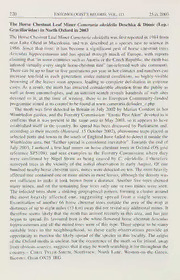
The Horse Chestnut Leaf Miner Cameraria ohridella Deschka & Dimic (Lep.: Gracillariidae) in North Oxford in 2003 PDF
Preview The Horse Chestnut Leaf Miner Cameraria ohridella Deschka & Dimic (Lep.: Gracillariidae) in North Oxford in 2003
220 ENTOMOLOGIST'S RECORD, VOL. 15 25.ix.2003 1 The Horse Chestnut Leaf Miner Cameraria ohridella Deschka & Dimic (Lep.: Gracillariidae) in North Oxford in 2003 The Horse Chestnut Leaf Miner Cameraria ohridella was first reported in 1984 from near Lake Ohrid in Macedonia, and was described as a species new to science in 1986. Since that time, it has become a significant pest of horse chestnut trees Aesculus hippocastanum and has spread through much of Europe, with reports claiming that “in some countries such as Austria or the Czech Republic, the moth has infested virtually every single horse-chestnut tree” (un-refereed web site comment). There can be up to four or five generations per year in hot climates and numbers can increase ten-fold in each generation under natural conditions, so highly-visible browning of the leaves soon appears, leading to complete defoliation in extreme cases. As a result, the moth has attracted considerable attention from the public as well as from entomologists, and an internet search reveals hundreds of web sites devoted to it; at the time of writing, there is an European Community-funded programme aimed at its control to be found at www.cameraria.de/index_e.php. The moth was first detected in Britain in July 2002 by Marian Comfort in her Wimbledon garden, and the Forestry Commission “Exotic Pest Alert” devoted to it confirms that it was present in the same area in May 2003, so it appears to have established itself in the country. Its spread has been discussed by Parliament and. according to their records Hansard 15 October 2002), pheromone traps placed at ( , selected ports and towns in the south of England have failed to detect it ouside the Wimbledon area, but “further spread is considered inevitable”. Towards the end of July 2003, I noticed a few leaf mines on horse chestnut trees in Oxford (OS grid reference SP5108), and sent examples to the Forestry Commission where they were confirmed by Nigel Straw as being caused by C. ohridella. therefore I surveyed trees in the vicinity of the initial observation in early August, Of one hundred nearby horse chestnut trees, mines were detected on ten. The most heavily affected tree contained one or more mines in most leaves, although the density was not sufficient to make it look brown from a distance. Another five trees showed many mines, and on the remaining four trees only one or two mines were seen. The infected trees show a striking geographical pattern, forming a cluster around the most heavily affected one, suggesting spread from a single source. Examination of another 66 horse chestnut trees outside the area of the map at distances of up to eight miles ( 13 km) away did not reveal any additional mines. It therefore seems likely that the moth has arrived recently in this area, and has just begun to spread. Its favoured host is the white-flowered horse chestnut Aesculus hippocastanum and all the mined trees were of this type. There appear to be many suitable trees in the neighbourhood, so these early observations provide an opportunity to monitor the likely spread of the species in this locality. The origin of the Oxford moths is unclear, but the occurrence of the moth so far inland, away from obvious sources, suggests that it may be worth searching it for throughout the country.- Chris Tyler-Smith, Northview, North Lane, Weston-on-the-Green, Oxon 0X25 3RG. Bicester,
